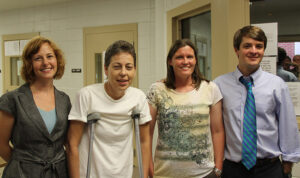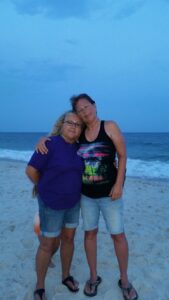Tami Vance will never forget the moment her trial judge told her and her co-defendant Leigh Stubbs that because they loved each other — because they were openly lesbians — they deserved to spend the rest of their lives in prison.
“He said he was gonna make sure that we did, and then he gave us 44 years to serve,” Ms. Vance recalled. What made it even worse was knowing that they hadn’t committed the crime they’d been convicted of.
A biased trial and invalid bite mark evidence
In 2001, Ms. Vance and Ms. Stubbs were convicted of assaulting their friend, Kimberly Williams, in Mississippi. The conviction was largely based on bite mark evidence — a debunked forensic method — and a biased trial in which witnesses and “experts” gave testimony replete with anti-LGBTQ statements. In fact, when Ms. Vance’s attorney asked the jury before the trial began if they would be able to vote Ms. Vance not guilty based on their own “personal morality” knowing that there would be testimony about “lesbian behavior,” two jurors admitted they would vote Ms. Vance and Ms. Stubbs guilty, knowing nothing else about the case.
“This case was a confluence of faulty forensic evidence — bogus bite mark evidence — homophobia, stereotypes about drug use, and bias against substance use disorders, which all converged together to lead to these wrongful convictions,” said Valena Beety, who represented Ms. Stubbs in her post-conviction litigation. Ms. Beety is the author of Manifesting Justice: Wrongly Convicted Women Reclaim Their Rights, in which she details the injustices Ms. Vance and Ms. Stubbs overcame.
“This case really highlights how sexual orientation and queer identity can be weaponized,” Ms. Beety, who is also the founding director of the West Virginia Innocence Project, said.

Tami Vance (second from left) and Leigh Stubbs (third from left). (Image: Mississippi Innocence Project)
In 2000, Ms. Vance and Ms. Stubbs called 911 after noticing Ms. Williams was having trouble breathing in an apparent drug overdose. Ms. Vance and Ms. Stubbs took turns performing CPR on Ms. Williams, whom they met while at a rehabilitation facility where all three were receiving treatment, until the paramedics arrived. After unsuccessfully attempting to revive Ms. Williams with CPR, the paramedics administered Narcan, and Ms. Williams began breathing again but remained unconscious as she was taken to the hospital.
Ms. Williams was diagnosed as having overdosed, but a doctor who noticed some bruising speculated that she had been sexually assaulted days before “from the coloring” of her injuries. That same day, Ms. Williams was transported to another hospital and suffered seizures during the hour-long drive.
The detective on the case, Nolan Jones, called in his friend Michael West, a dentist and a forensic odontologist, whose testimony on bite mark identifications contributed to the wrongful convictions of several now exonerated Innocence Project clients. To date, more than 30 people wrongly convicted based on bite mark evidence have been exonerated. Dr. West testified in at least half a dozen of those cases.
Although no medical staff reported seeing any alleged bite marks on Ms. Williams, Dr. West took close-up photos and video footage of Ms. Williams’ breasts and genitals, and claimed to have found bite marks and cigarette burns on her body. He then claimed he had “matched” the bite marks to Ms. Stubbs after having created additional bruises on Ms. Williams’ body by pressing a mold of Ms. Stubbs’ teeth into Ms. Williams’ hip.
LGBTQ discrimination on the stand and beyond
At trial, Dr. West testified that “it wouldn’t be unusual” to find bite marks in a “homosexual rape case” and said it would “almost” be expected in such a case when asked by the prosecutor. He also claimed that part of Ms. Williams’ genitals had been bitten off, which he called a “usually a combative or a sexual orientation phenomenon.”
Dr. West was far from the only person to make such unfounded, homophobic statements at trial. One doctor, a pathologist and expert for the defense, testified that bite marks were “consistent” with what he’d expect to find in a homosexual rape case, saying, “In homosexual crimes, all, they are very sadistic. Most violent times I’ve seen in my experience are homosexual to homosexual. They do what we call overkill. They do tremendous damage, tremendous damage.”
Ms. Vance said she often felt her sexuality was more accepted in prison than outside of it.
Both Ms. Stubbs and Ms. Vance were the subjects of discrimination during their trial. Ms. Vance, who is less femme-presenting, was the target of particularly hateful character assassination and derogatory language. In fact, “police were more reluctant to prosecute Leigh than Tami — even though under their own ‘evidence,’ Leigh’s teeth allegedly matched the bite mark,” Ms. Beety writes in her book.
The different treatment that Ms. Stubbs and Ms. Vance received based on their appearance and perceptions of them reflects the many ways members of the LGBTQ community experience discrimination at the hands of law enforcement and the criminal legal system. A recent survey found that LGB people are incarcerated at a rate more than three times higher than the overall adult incarceration rate, and that about one-third of incarcerated women identify as lesbian or bisexual. In fact, Ms. Vance said she often felt her sexuality was more accepted in prison than outside of it.
Trans people, in particular, tend to be arrested and harassed by police more often for lower-level or false charges than other members of the LGBTQ community, Ms. Beety said. She added that, in her work, she has also witnessed prosecutors attempt to assassinate the characters of trans people in order to exploit potential biases jurors might hold, consciously or unconsciously.
In Ms. Vance and Ms. Stubbs’ case, the prosecution painted the LGBTQ community as inherently violent and vicious, a sentiment the judge reiterated when giving the women the maximum sentence. The women spent nearly 11 years wrongly incarcerated before being freed and exonerated in 2012. They were represented by Ms. Beety and the Mississippi Innocence Project.
‘I’m fixing to watch my whole life rebuild’
Despite these grave injustices, Ms. Vance said she considers herself “so blessed.” She feels lucky to have had a supportive family since coming out at the age of 18, but she emphasized how her wrongful conviction weighed heavily on them.
“Families go to prison with their children — the day their child goes to prison, they go too, they do time on the outside while you’re doing time on the inside, my mother did 11 years just like I did,” she said.
“I’ve watched my whole life crumble, but I’m fixing to watch my whole life rebuild”“I’ve watched my whole life crumble, but I’m fixing to watch my whole life rebuild”Since being freed, Ms. Vance has spent much of her time with her family and helping those around her. Now, she plans to take some time to focus on herself, after being diagnosed with PTSD.
“I’ve watched my whole life crumble, but I’m fixing to watch my whole life rebuild,” she said. “I’m taking out the trash on the inside — all the negativity and feelings, and letting them go.”

Tami Vance (right) enjoying the beach with a friend. (Image: Courtesy of Tami Vance)
She has big plans to finish restoring and decorating her trailer, which she dubbed “Hippie Nation.” So far, she has decked the trailer with wood beams on the ceiling, posters of Janis Joplin, Jimi Hendrix, Bob Marley, Pink Floyd, Led Zeppelin, and Melissa Etheridge, and dream catchers. She said she has only used colors that remind her of the beach — her favorite place — in the trailer.
While Ms. Vancesaid she is pleased to see progress made in advancing LGBTQ rights and acceptance, there is still a long way to go.
“I think people should be way more understanding. We’re all the same — everybody bleeds red,” she said. Ms. Vance said she’s not sure if she would experience less discrimination at trial if her wrongful conviction case were tried today.
Ms. Beety additionally stressed that queer visibility matters in helping to combat discrimination and prevent its role in wrongful convictions.
“We have to show ourselves and be seen in our full identities,” she said. “Because otherwise, that leads to decision makers being able to single out an individual for their gender expression for their presentation, and again, falsely attribute criminality to marginalized identities.”
Ms. Vance said she ultimately hopes people will recognize the power that prosecutors hold and more importantly, the power that each individual has to hold those very prosecutors accountable in states where such officials are elected.
Manifesting Justice: Wrongly Convicted Women Reclaim Their Rights by Valena Beety tells the story of Ms. Vance and Ms. Stubbs’ wrongful convictions, the stories of other wrongly convicted women and queer people, and explains what we can do to free them.
The post ‘Bite Marks,’ Homophobia, and Bias: How Two Women Were Wrongly Convicted Because They Loved Each Other appeared first on Innocence Project.
This content originally appeared on Innocence Project and was authored by Dani Selby.
Dani Selby | Radio Free (2022-06-27T21:59:56+00:00) ‘Bite Marks,’ Homophobia, and Bias: How Two Women Were Wrongly Convicted Because They Loved Each Other. Retrieved from https://www.radiofree.org/2022/06/27/bite-marks-homophobia-and-bias-how-two-women-were-wrongly-convicted-because-they-loved-each-other/
Please log in to upload a file.
There are no updates yet.
Click the Upload button above to add an update.